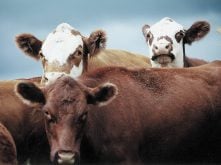This cattle market information is selected from the weekly report from Canfax, a division of the Canadian Cattlemen’s Association. More market information, analysis and statistics are available by becoming a Canfax subscriber by calling 403-275-5110 or at www.canfax.ca.
Fed cattle trade
Alberta direct cattle sales saw active trade for the week ending Jan. 11, and weighted average prices trended fully steady with last week at $160.69 per hundredweight and $159.50 per cwt for steers and heifers, respectively.
Read Also

Prairies have variable soil moisture conditions
The dry weather in the west was welcome for preserving grain quality and advancing harvest, but it has resulted in very dry soil moisture conditions.
Light live trade was reported from $159-161.50 per cwt., and dressed sales ranged from $268-$270 per cwt. delivered. Nearly 80 percent of cattle were sold on a carcass basis.
Fed prices next week are anticipated to be generally steady.
Canadian steer carcass weights for the week ending Jan.5 were down six pounds from the previous week, but on average they are greater than the five-year average. Last week they were 928 lb., making them 16 lb. heavier than the same time last year. With carcass weights larger than a year ago, weights will need to be managed moving forward.
From the start of the year through to the end of the first quarter, Canadian steer carcass weights have eased lower seven out of the past 10 years.
Heavyweight feeders in demand
A small price difference has been noted among heavier feeders, where 900 lb. plus steers were bringing the same price as 700-800 lb. steers. For the last four years, these heavyweights have established first quarter highs during the first week in January with prices sliding downward into the spring.
Alberta steers in the 700-800 pound category averaged $194 per cwt. compared to the next level where the 900 lb. or greater category averaged $185.33.
Ontario steers weighing 700-800 lb. were $10 lower at $184 per cwt., but the heavier cattle weighing more than 900 pounds were $1 higher than Alberta.
Cows trading higher
Compared to the end of December, D2 cow prices are trading $5 per cwt. higher through commercial auction facilities.
Western D2 cows averaged $82.67 per cwt. compared to $56.80 per cwt. in the eastern market.
January is traditionally a big cow slaughter month as cows that were put on feed during the fall are marketed. There were reports that one western Canadian packer was bought out until February, while the other two packers would lift the cows in one to two weeks.
The long-term seasonal index would suggest there is more upside to the non-fed market, but over the past three years cow prices have trended lower from January to February.
U.S. 90 percent trim prices have reached US$200 per cwt., which should continue to support the non-fed market.
Beef trade
U.S. cut-out values traded seasonally lower this week on typical soft post-holiday season beef demand. The Choice composite slipped $2.50 per cwt. lower than the previous week, and Select was $1.61 per cwt. lower. All Choice primals trended lower this week. Select ends traded lower, while middle cut rib and loin prices firmed modestly higher to narrow the Choice/Select spread to $6.19 per cwt.
Wholesale and retail beef demand is often lacklustre after the holidays with prices hitting one of the lowest points of the year in mid-January. Beef demand is expected to remain uneventful until the second quarter of the year.














